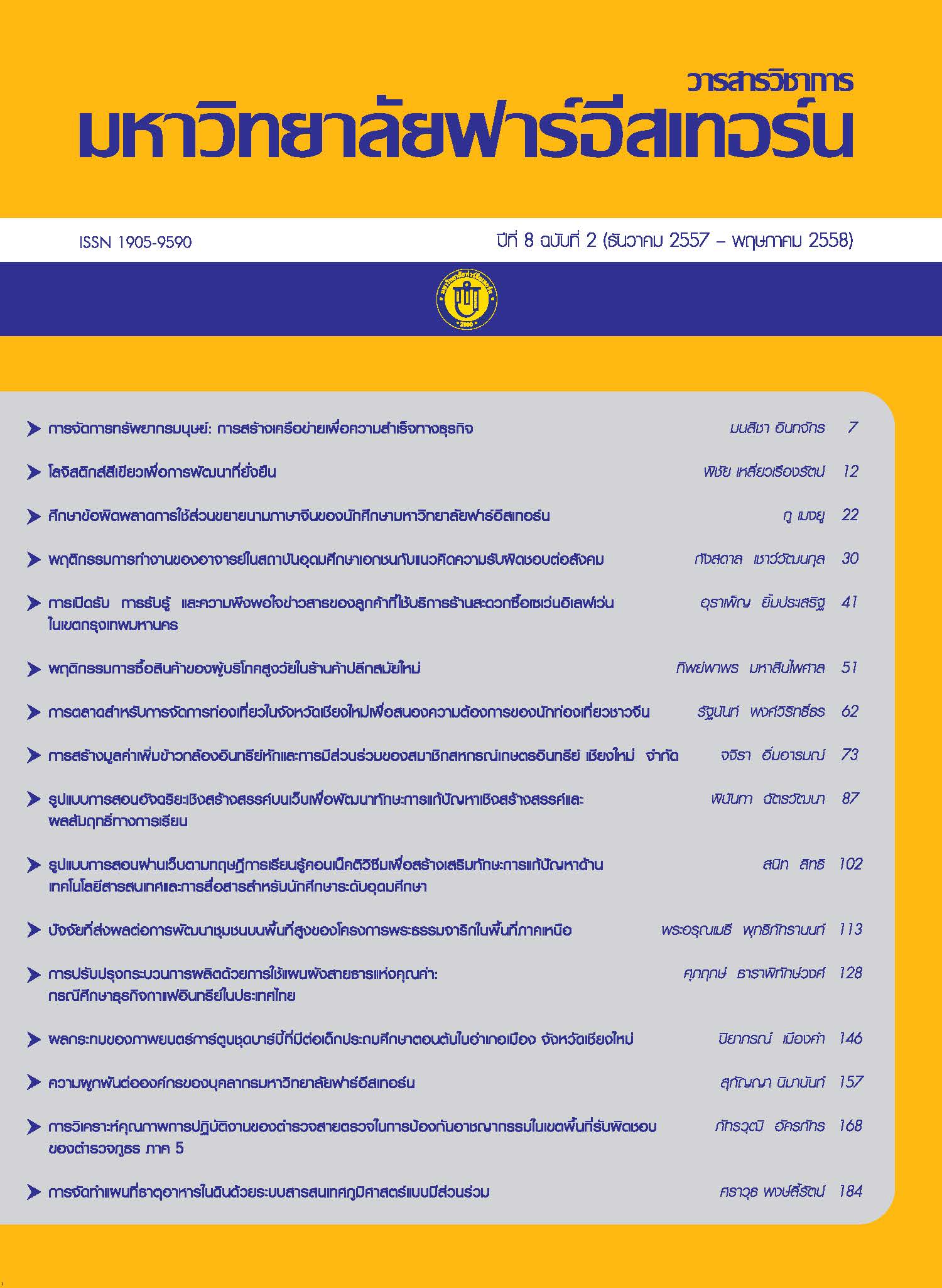ปัจจัยที่ส่งผลต่อการพัฒนาชุมชนบนพื้นที่สูงของโครงการพระธรรมจาริกในพื้นที่ภาคเหนือ
Main Article Content
บทคัดย่อ
การวิจัยครั้งนี้มีวัตถุประสงค์ เพื่อศึกษาผลการพัฒนาชุมชนบนพื้นที่สูงและปัจจัยที่ส่งผลต่อความสำเร็จการพัฒนาชุมชนบนพื้นที่สูงและศึกษาแนวทางการพัฒนาชุมชนบนพื้นที่สูงของโครงการพระธรรมจาริกในพื้นที่ภาคเหนือ โดยผู้วิจัยได้ศึกษาจากอาศรมพระธรรมจาริกหลักที่มีระยะเวลาในการก่อตั้ง 5 ปีขึ้นไป จำนวน 77 แห่ง ได้กลุ่มตัวอย่าง 65 แห่ง ในพื้นที่ 9 จังหวัดทางภาคเหนือ คือ เชียงใหม่ เชียงราย แม่ฮ่องสอน น่าน พะเยา ลำปาง ตาก สุโขทัย และเพชรบูรณ์ การวิจัยนี้ใช้วิธีการวิจัยแบบผสมผสานทั้งเชิงปริมาณและเชิงคุณภาพ สำหรับข้อมูลเชิงปริมาณได้มาจากแบบสัมภาษณ์แบบมีโครงสร้างจากกลุ่มตัวอย่าง 3 กลุ่ม คือ พระธรรมจาริก 65 รูป แกนนำชุมชน 65 คน และชาวบ้านในชุมชน 390 คน รวม 520 รูป/คน ข้อมูลที่เก็บรวบรวมจากแบบสัมภาษณ์แบบมีโครงสร้าง ได้นำมาวิเคราะห์ด้วยวิธีการทางสถิติหาค่าความถี่ ค่าร้อยละ ค่าเฉลี่ย ค่าส่วนเบี่ยงเบนมาตรฐาน ค่าสัมประสิทธิ์สหสัมพันธ์แบบเพียร์สัน และการพยากรณ์โดยการถดถอยพหุคูณแบบขั้นตอน ส่วนข้อมูลเชิงคุณภาพได้จากการสัมภาษณ์เชิงลึกพระธรรมจาริก แกนนำชุมชน และชาวบ้านที่อาศัยอยู่ในพื้นที่การทำงานของอาศรมพระธรรมจาริกหลักที่มีระดับการพัฒนาชุมชนบนพื้นที่สูงที่เป็น Best Practice และมีผลการพัฒนาอยู่ในระดับสูงสุดของ 6 มิติ คือ การพัฒนาจิตใจ การพัฒนาสังคม การพัฒนาเศรษฐกิจ การพัฒนาสาธารณสุข การพัฒนาสิ่งแวดล้อม และการพัฒนาการศึกษา จำนวน 6 แห่ง จากกลุ่มตัวอย่าง 3 กลุ่ม คือ พระธรรมจาริก 6 รูป แกนนำชุมชน 6 คน และชาวบ้านในชุมชน ชุมชนละ 5 คน รวม 30 รูป/คน ข้อมูลที่ได้นำมาวิเคราะห์สรุปบรรยายเชิงพรรณนา
ผลการวิจัย พบว่า
1. ผลการพัฒนาชุมชนบนพื้นที่สูงของโครงการพระธรรมจาริกในพื้นที่ภาคเหนือ โดยรวมมีผลการพัฒนาอยู่ในระดับปานกลาง มีค่าเฉลี่ยเท่ากับ 3.10 เมื่อพิจารณาแต่ละมิติ พบว่า มิติการพัฒนาด้านจิตใจ มีระดับการพัฒนาอยู่ในระดับมาก มีค่าเฉลี่ยเท่ากับ 3.74 ส่วนมิติที่มีการพัฒนาอยู่ในระดับปานกลางมี 4 มิติ โดยเรียงระดับการพัฒนาจากมากไปหาน้อย คือ มิติการพัฒนาด้านสังคม มีค่าเฉลี่ยเท่ากับ 3.46 มิติการพัฒนาด้านสิ่งแวดล้อม มีค่าเฉลี่ยเท่ากับ 3.15 มิติการพัฒนาด้านสาธารณสุขมีค่าเฉลี่ยเท่ากับ 2.94 และมิติการพัฒนาด้านการศึกษา มีค่าเฉลี่ยเท่ากับ 2.92 ส่วนมิติการพัฒนาด้านเศรษฐกิจ มีค่าเฉลี่ยเท่ากับ 2.42 ซึ่งมีระดับการพัฒนาอยู่ในระดับน้อย
2. ปัจจัยที่ส่งผลต่อความสำเร็จการพัฒนาชุมชนบนพื้นที่สูงของโครงการพระธรรมจาริกในพื้นที่ภาคเหนือ พบว่า ปัจจัยด้านการทำงานเป็นทีมส่งผลอยู่ในระดับมากสุด คือ การทำงานเป็นทีมของพระธรรมจาริกกับแกนนำและชาวบ้านในชุมชน องค์ประกอบที่ส่งผล ได้แก่ การสร้างบุคลากรและการมีส่วนร่วมของสมาชิกในทีมงาน รองลงมาปัจจัยด้านศักยภาพพระธรรมจาริก องค์ประกอบที่ส่งผล ได้แก่ ประสบการณ์ทำงานของพระธรรมจาริกและการสร้างแรงจูงใจในการทำงาน และปัจจัยการมีส่วนร่วม องค์ประกอบที่ส่งผล ได้แก่ การมีส่วนร่วมวางแผน/ร่วมตัดสินใจ และการมีส่วนร่วมดำเนินการ/ร่วมรับผิดชอบ ระหว่างพระธรรมจาริก แกนนำชุมชนและชาวบ้านในการพัฒนาชุมชนบนพื้นที่สูง
3. แนวทางการพัฒนาชุมชนบนพื้นที่สูงของโครงการพระธรรมจาริกในพื้นที่ภาคเหนือ คือ โครงการพระธรรมจาริกควรสร้างกระบวนการ ให้พระธรรมจาริกกับชาวบ้านในชุมชน่ทำงานร่วมกันเป็นทีมอย่างเข้มแข็งเพื่อพัฒนาชุมชน พร้อมทั้งพัฒนาศักยภาพพระธรรมจาริกให้มีความรู้และทำงานอย่างมีคุณภาพ รวมทั้งกำหนดให้พระธรรมจาริกสร้างกลไกการมีส่วนร่วมกับแกนนำชุมชนและชาวบ้านในชุมชนเพื่อให้เกิดความร่วมมือในการพัฒนาอย่างบูรณาการ อีกทั้งโครงการพระธรรมจาริกควรสร้างคู่มือการพัฒนาชุมชนแก่พระธรรมจาริก ที่ปฏิบัติงานในชุมชนของแต่ละชนเผ่า พร้อมกับการสร้างกลไกหนุนเสริมงบประมาณและวัสดุอุปกรณ์ในการพัฒนาชุมชนบนพื้นที่สูงให้มีประสิทธิภาพมากยิ่งขึ้น
This research aims to study the result of the community development in the highland area and analyze the factors affecting the success in the community development in the highland area as well as the guidelines of the community development in the highland of Phradhammajarika projects in the northern region. Researcher study have been established for 5 years or more 77 main Phradhammajarika ashrams. were carried out to the samples living in the following places: 65 main Phradhammajarika ashrams and placed in 9 provinces in the northern region such as Chiang Mai, Chiang Rai, Mae Hong Son, Nan, Phayao, Lampang, Tak, Sukhothai and Phetchaboon.
This research used a combination of research methods, was quantitative and qualitative. The quantitative data was from structured interview carried out to 3 groups of samples as follows: 65 Phradhammajarika, 65 community leaders and 390 local people in community at the total of 520 people. Data collected from this interview were analyzed by statistic method to find out frequency, percentage, mean, standard deviation, Pearson's product moment coefficient and Stepwise multiple regression analysis. However, qualitative data were obtained from in-depth interview of 6 main Phradhammajarika ashrams providing the level of the community development in the highland at The Best Practice which contained the result of the development at the highest level of each dimension. There were 6 dimensions all together such as dimension of mind development, social development, economic development, public health development, environmental development and educational development. 3 groups of samples interviewed were 6 Phradhammajarika, 6 community leaders, 5 people from each community at the total of 30 people. Data collected were analyzed and concluded as descriptive report.
The result of the research found that:
1. The overall result of the community development in the highland of the Phradhammajarika projects in the northern region was at the medium level with the mean equivalent to 3.10. Looking closer at each dimension, it is found that dimension of mind development was at high level with the mean equivalent to 3.74 while there were 4 dimensions that the developments were at medium level such as dimension of social development providing the mean equivalent to 3.46, dimension of environmental development providing the mean equivalent to 3.15, dimension of public health development providing the mean equivalent to 2.95 and dimension of educational development providing the mean equivalent to 2.92. The dimension of economic development was at the low level with the mean equivalent to 2.42.
2. As for factors affecting the success in the community development in the highland of the Phradhammajarika projects in the northern region, it is found that the factor of team work affected at the highest level. The teams mentioned were Phradhammajarika, community leaders and people living in community working together. The elements affecting the success were such as staff formation and members in the team participation. The second highest level was the factor of Phradhammajarika potentiality. The elements affecting were such as the work experience of Phradhammajarika and motives creation in working. The elements affecting in the factor of participation were such as the participation in planning/decision-making and participation in working/taking responsibilities between Phradhammajarika, community leaders and people in community to work together in community development in the highland.
3. The guidelines in developing community in the highland of the Phradhammajarika projects in the northern region was that Phradhammajarika projects should create the process to encourage Phradhammajarika and people in community to work together forcefully as a team to develop the community as well as improve efficiently the potentials of Phradhammajarika by providing them the knowledge and work experience. Phradhammajarika should be able to build the participation mechanism with community leaders and local people in order to create the cooperation in integrated development. Moreover, Phradhammajarika projects should write handbook about the community development for other Phradhammajarika working in community of each tribe as well as establish the mechanism supporting the budget and materials used in developing the communities in the highland to be more effective.
Article Details
1. ทัศนะและข้อคิดเห็นใดๆ ในวารสารนวัตกรรมสังคมและการเรียนรู้ตลอดชีวิตเป็นทัศนะของผู้เขียน กองบรรณาธิการไม่จำเป็นต้องเห็นพ้องด้วยกับทัศนะเหล่านั้นและไม่ถือว่าเป็นความรับผิดชอบของกองบรรณาธิการ
2. ความรับผิดชอบด้านเนื้อหาและการตรวจร่างบทความแต่ละบทเป็นของผู้เขียนแต่ละท่าน กรณีมีการฟ้องร้องเรื่องการละเมิดลิขสิทธิ์ถือเป็นความรับผิดชอบของผู้เขียนแต่เพียงฝ่ายเดียว
3. ลิขสิทธิ์บทความเป็นของผู้เขียนและมหาวิทยาลัยฟาร์อีสเทอร์นได้รับการสงวนสิทธิ์ตามกฎหมาย การตีพิมพ์ซ้ำต้องได้รับอนุญาตโดยตรงจากผู้เขียนและมหาวิทยาลัยฟาร์อีสเทอร์นเป็นลายลักษณ์อักษร

